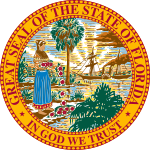History of florida
| History of Florida | |
|---|---|

The seal of Florida reflects the state's Native American ancestry
|
|
| Historical Periods | |
| Pre-history | until 1497 |
| Spanish Rule | 1513–1763 |
| British Rule | 1763–1783 |
| Spanish Rule | 1783–1821 |
| U.S. Territorial Period | 1822–1845 |
| Statehood | 1845–present |
| Major Events | |
| American Revolutionary War | 1775–1783 |
| War of 1812 | 1811–1814 |
| First Seminole War | 1817–1818 |
| Capitol moved to Tallahassee |
1824 |
| Second Seminole War | 1835–1842 |
| Constitutional convention | 1838 |
| Third Seminole War | 1855–1858 |
| Ordinance of Secession | 1861 |
| Civil War | 1861–1865 |
| 3rd Constitution | 1865 |
| Reconstruction | 1865–1868 |
| 4th Constitution | 1868 |
| 5th Constitution | 1885 |
| Great Migration | 1910–1930 |
| Land Boom | 1925–1929 |
| 6th Constitution | 1968 |
|
Gore v. Harris 2000 Presidential Election |
2000 |
| Timeline | |
The history of Florida can be traced back to when the first Native Americans began to inhabit the peninsula as early as 14,000 years ago. They left behind artifacts and archeological evidence. Written history begins with the arrival of Europeans to Florida; the Spanish explorer Juan Ponce de León in 1513 made the first textual records. The state was the first mainland realm of the United States to be settled by Europeans. Thus, 1513 marked the beginning of the American Frontier.
From that time of contact, Florida has had many waves of immigration, including French and Spanish settlement during the 16th century, as well as entry of new Native American groups migrating from elsewhere in the South, and free blacks and fugitive slaves, who became known as Black Seminoles. Florida was under colonial rule by Spain, France, and Great Britain during the 18th and 19th centuries before becoming a territory of the United States in 1821. Two decades later, in 1845, Florida was admitted to the union as the 27th US state. Since the 19th century, immigrants have arrived from Europe, Latin America, Africa and Asia.
Florida is nicknamed the "Sunshine State" due to its warm climate and days of sunshine, which have attracted northern migrants and vacationers since the 1920s. A diverse population and urbanized economy have developed. In 2011 Florida, with over 19 million people, surpassed New York and became the third largest state in population.
The economy has developed over time, starting with natural resource exploitation in logging, mining, fishing, and sponge diving; as well as cattle ranching, farming, and citrus growing. The tourism, real estate, trade, banking, and retirement destination businesses followed.
The foundation of Florida was located in the continent of Gondwana at the South Pole 650 Mya. When Gondwana collided with the continent of Laurentia 300 Mya, it had moved further north. 200 Mya, the merged continents containing what would be Florida, had moved north of the equator. By then, Florida was surrounded by desert, in the middle of a new continent, Pangaea. When Pangaea broke up 115 mya, Florida assumed a shape as a peninsula. The emergent landmass of Florida was Orange Island, a low-relief island sitting atop the carbonate Florida Platform which emerged about 34 to 28 million years ago.
...
Wikipedia
